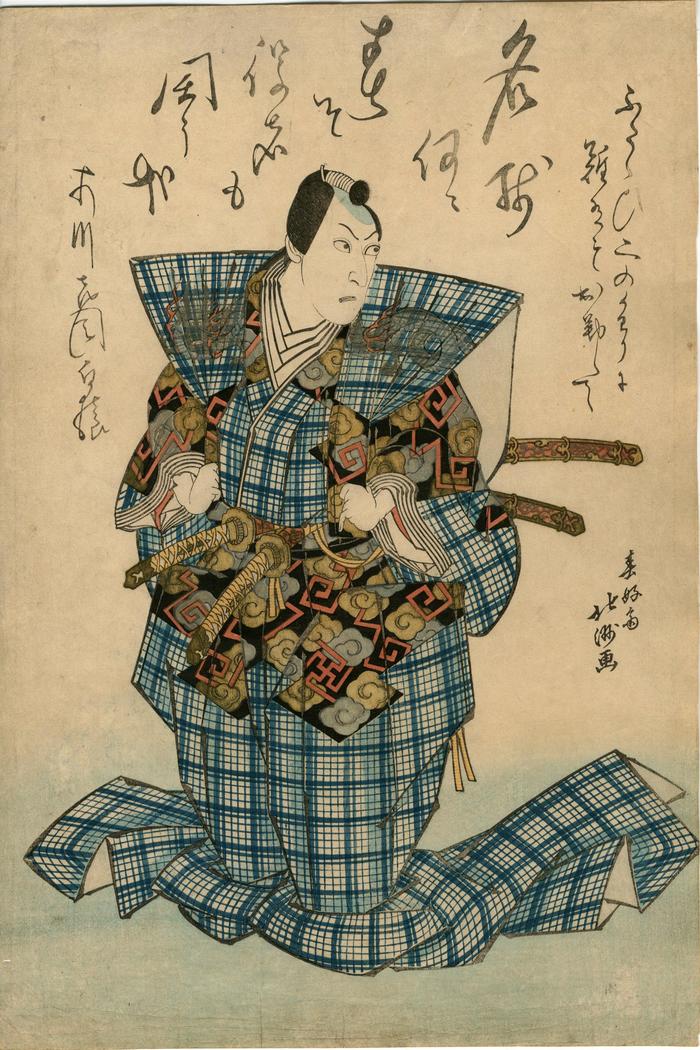Shunkōsai Hokushū (春好斎北洲) (artist ca 1808 – 1832)
Ichikawa Hakuen II (市川白猿) as Saeda Masazaemon (早枝政右衛門)
01/1830
10 in x 14.75 in (Overall dimensions) Japanese woodblock print
Signed: Shunkōsai Hokushū ga
春好斎北洲画
Museum of Fine Arts, Boston
Waseda University
National Museum of Asian Art
Hankyu Culture Foundation
Minneapolis Institute of Art
Musées royaux d'art et d'histoire This is the left panel of a diptych. The right panel is by Shigeharu. Ichikawa Danjūrō VII performed under the name Hakuen while in Osaka in 1829-30. Danjūrō had traveled there because the theaters in Edo had burned.
Here he is shown dressed in the formal wear of a samurai, including a stiff overrobe (kataginu) decorated with a dragon, cloud, and stylized lightning-bolt motif, and long trousers (nagabakama). The costume is linked to the role of Saeda Masazaemon in Keisei setsugekka ('Snow, moon, and flowers in the pleasure quarters')....
"Danjūrō's haiku, 'Ichikawa dai-me Hakuen,' is rendered in the actor's distinctive handwriting:
nagori nanniso what! This spring, it seems,
haru zo yakusha mo
ūru kan
actors, too, get an extra month!
Another version of this print in the Ikeda Bunko Collection includes the same poem, but with a different headnote by the actor, mentioning that he was scheduled to perform this role twice."
[Translation by John T. Carpenter]
This information comes from Masterful Illusions: Japanese Prints in the Anne van Biema Collection, p. 164.
This print in the collection of the National Museum of Asian Art differs in the text in the upper right and should be used for comparison. That copy shows both the publisher's seal for Tenmaya Kihei and the carver Kasuke.
****
There is another collaborative diptych by Kunihiro and Shigeharu in the Lyon Collection, #415. It, too, shows a scene from this play, but has a whole different feel.
****
The text on the print in the Lyon Collection reads:
ふたゝひ二のかわりに難有も出勤して 名残何に春そ役者も閏う哉 市川七代目白猿 (JSV)
****
The example in the Museum of Fine Arts in Boston shows a publisher's seal for Honsei and a carver's seal for Kasuke. this example in the Lyon Collection does not have those seals. (JSV)
****
Illustrated:
1) in black and white in The Legacy of Japanese Printmaking/Le Rayonnement de l'estampe Japonaise by Barry Till, the Art Gallery of Victoria, 1986, pl. #36. [There are two Hokushū prints listed in this catalogue as #36.]
2) in color - the whole diptych - in Schätze der Kamigata: Japanische Farbholzschnitte aus Osaka 1780-1880, MNHA (Musée national d'histoire et d'art Luxembourg), 2012, p. 197, #419. This catalogue identifies this figure as Hayaeda Masaemon. The accompanying text to the right-hand panel reads:
"Iro Usuki Tera Kara Hirakan Fuyu no Ume"
Wenn ich auch wenig geachter bin, so möchte ich doch noch einmal den Weg freimachen wie die Pflaumenblüte im Winter.
Of the left-hand sheet it says:
[Ichikawa Hakuen als Hayeda Masaemon] mit seiner Ansprache "Futabi Ninokawari ni Arigataku mo Otsutome Shite" (Hier kommen ich wieder trotz der Schwierigkeiten) und seinem Kyoku-Gedicht, signiert Ichikawa Kimoku Hakuen "Miwasa Gata Haru zo Yakusha mo Uru Kana" (Ich hoffe, mein neuer Name bringt mir Erfolg bis zum nahen Frühlingsfest).
Using Google translate the accompanying text to the right-hand panel reads:
"Iro Usuki Tera Kara Hirakan Fuyu no Ume"
Although I don't have much respect for it, I would still like it again Clear the way like the plum blossom in winter.
Of the left-hand sheet it says:
[Ichikawa Hakuen as Hayeda Masaemon] with his speech "Futabi Ninokawari ni Arigataku mo Otsutome Shite" (Here I come again despite the difficulties) and his Kyoku poem, signed Ichikawa Kimoku Hakuen "Miwasa Gata Haru zo Yakusha mo Uru Kana" (I hope my new name brings me success until the Spring Festival is near).
3) in color in Kabuki Heroes on the Osaka Stage 1780-1830 by C. Andrew Gerstle, University of Hawai'i Press, page 287, #270. The whole diptych is illustrated. The text reads: "The diptych is lavishly produced in surimono style, with especially fine carving and special metallic printing - the work of Kasuke the 'carver of surimono' (surimono hori Kasuke), as announced in the hand-impressed seal, bottom right.... The poems are by the two actors..."
4) in color in a full-page reproduction in Masterful Illustions: Japanese Prints in the Anne van Biema Collection by Ann Yonemura, the Smithsonian Institution with the University of Washington Press, 2002, page 57. Only this half of the diptych is illustrated.
actor prints (yakusha-e - 役者絵) (genre)
Kyōto-Osaka prints (kamigata-e - 上方絵) (genre)
Ichikawa Hakuen II (二代目市川白猿) (actor)
